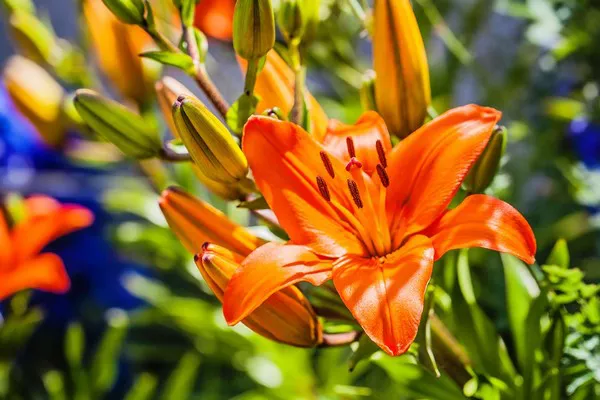Creating a beautiful outdoor garden is a delight for any nature enthusiast, but if you share your space with a feline friend, it’s essential to consider their safety as well. Some outdoor flowers and plants can be toxic to cats and may pose a health risk if ingested. In this comprehensive guide, we will explore a variety of outdoor flowers that are safe for cats, along with tips for creating a feline-friendly garden and the potential dangers of toxic plants.
Creating a Feline-Friendly Garden
1. Choose Cat-Safe Flowers
When planning your outdoor garden, opt for flowers and plants that are non-toxic to cats. This ensures a safe and enjoyable environment for both you and your feline companion.
2. Provide Alternative Play Areas
Cats love to explore and play outdoors. Create designated play areas with cat-friendly toys and climbing structures to keep your furry friend engaged and entertained.
3. Limit Access to Toxic Plants
If you have plants in your garden that are toxic to cats, consider limiting your cat’s access to those areas. Fencing or using plant pots out of reach can help prevent accidental ingestion.
4. Create Shade and Shelter
Provide shaded areas and shelters in your garden where your cat can rest and relax comfortably during hot weather or rain.
Cat-Safe Outdoor Flowers
1. Roses (Rosa spp.)
Roses are a popular outdoor flower, and fortunately, many varieties are safe for cats. However, it’s essential to avoid using chemical pesticides on roses to ensure your cat’s safety.
2. Marigolds (Tagetes spp.)
Marigolds are vibrant and low-maintenance flowers that add a splash of color to any garden. These cheerful blooms are safe for cats and can also repel certain garden pests.
3. Sunflowers (Helianthus spp.)
Sunflowers are known for their tall and striking appearance. Their seeds and petals are non-toxic to cats, making them a safe and attractive addition to your garden.
4. Bachelor’s Buttons (Centaurea cyanus)
Bachelor’s buttons, also known as cornflowers, produce charming blue or purple flowers that cats can safely enjoy in your garden.
5. Snapdragons (Antirrhinum spp.)
Snapdragons are colorful and unique flowers that can add vertical interest to your garden. They are safe for cats and make lovely cut flowers for indoor arrangements.
6. Impatiens (Impatiens spp.)
Impatiens are popular for their vibrant blooms and shade tolerance. These flowers are non-toxic to cats, making them a great choice for gardens with partial shade.
7. Petunias (Petunia spp.)
Petunias come in various colors and patterns and are safe for cats. Their trumpet-shaped blooms are attractive and can add a touch of elegance to your garden.
8. Zinnias (Zinnia spp.)
Zinnias are easy to grow and offer a wide range of colors and shapes. They are safe for cats and butterflies, making them a delightful addition to a cat-friendly garden.
9. Alyssum (Lobularia maritima)
Alyssum is a delicate and fragrant flower that blooms profusely. Cats can safely explore and interact with these petite flowers in your garden.
10. Calendula (Calendula officinalis)
Calendula, also known as pot marigold, produces bright and cheerful flowers. It’s a cat-safe option for your garden and has various medicinal properties.
Potential Dangers: Toxic Plants for Cats
While many outdoor flowers are safe for cats, it’s crucial to be aware of toxic plants that can pose health risks if ingested by your feline companion. Some common garden plants that are toxic to cats include:
1. Lilies (Lilium spp. and Hemerocallis spp.)
Certain lily varieties, such as Easter lilies, tiger lilies, and daylilies, are highly toxic to cats and can cause severe kidney damage if ingested.
2. Azaleas and Rhododendrons (Rhododendron spp.)
These flowering shrubs contain toxins that can cause gastrointestinal issues, weakness, and even coma in cats.
3. Tulips and Daffodils (Tulipa spp. and Narcissus spp.)
These spring-blooming flowers contain toxins that can cause vomiting, diarrhea, and, in severe cases, heart issues in cats.
4. Oleander (Nerium oleander)
Oleander is a highly toxic plant that can lead to serious health problems, including cardiac issues, if ingested by cats.
5. Sago Palm (Cycas revoluta)
Sago palms contain toxins that can cause liver failure and even be fatal to cats if consumed.
Conclusion
Creating a feline-friendly outdoor garden involves selecting safe and non-toxic flowers for your furry friend to enjoy. Planting cat-safe flowers, providing play areas and shelter, and limiting access to toxic plants will ensure a safe and pleasant environment for your cat to explore and relax. By being aware of potential dangers and making thoughtful choices in your garden design, you can create a harmonious outdoor space that brings joy and enrichment to both you and your beloved feline companion.


